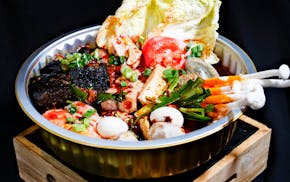Spinach is spinach, right? Nope.
I can assure you our local winter spinach is quite different from California's baby spinach sold plastic tubs. Its ruffled, deep green leaves are savory, crunchy and complex. Find winter spinach at our farmers markets and in local co-ops. This variety is grown in unheated, high-tunnel greenhouses and undergoes a freeze-thaw cycle each night that concentrates its sugar content.
Spinach originated in the Middle East and is actually a cold-weather plant. It is best when seeded in late fall to grow slowly over the winter. The commercial baby spinach from California has been bred to grow quickly for a spring harvest, a practice that ignores the plant's seasonal preference and its logical place in our food supply as a fall-winter crop.
Winter spinach is exactly what we need right now, bringing vibrant color and nutrients to our winter-weary meals. It's packed with vitamins A, C and K as well as folate, iron and magnesium.
Fresh winter spinach makes wonderful salads, especially when tossed with citrus and dried fruit; shred it for tacos, layer in sandwiches, twirl it into hot pasta, swirl into risotto, and pile it on top of polenta. It retains most of its texture and all of its color in the heat.
That's why winter spinach, earthy and grassy and vibrant, makes such a great match to lush, sunny eggs. Work it into a scramble or omelet, or sauté the spinach and top with a poached egg.
My favorite recipe is spinach quiche, one that's rich and lush with cheese and cream. Serve spinach quiche for brunch, lunch or a casual dinner, but do not serve it hot; it's best slightly warm or at room temperature, and it's even better paired with a crisp spinach salad on the side.
Spinach Quiche
Makes 1 (9-inch) pie.
This recipe calls for tangy Gruyère; a good sharp Cheddar or aged Gouda would work beautifully, too. You can make your own pie crust (find a recipe below), but I confess that when in a pinch, I'll cheat with a frozen all-butter crust from the grocery store. From Beth Dooley.
- 1 recipe butter crust (see recipe)
- 6 eggs
- ½ c. half-and-half or whole milk
- 1 c. shredded Gruyère cheese
- ½ c. minced green onions, mostly white part
- Generous pinch coarse salt and freshly ground black pepper
- Pinch red pepper flakes
- Pinch grated nutmeg
- 6 oz. fresh spinach, coarsely chopped
Directions
To prepare the crust: Preheat the oven to 425 degrees. Roll out the pie dough to about ⅛ inches thick. Drape the dough over your rolling pin and then unroll it over a 9-inch pie dish. Press it firmly into the bottom and up the sides. Trim off any excess dough allowing a ½-inch overhang on all sides. Roll the edge of the dough under itself and use your fingers or a fork to crimp. Prick the bottom of the pie with a fork, line with parchment and fill with dry beans or rice to reach the top of the crust. Bake until the edges are set, about 15 minutes. Remove the pie and lift the weights and discard the beans or rice. Return to the oven until the bottom is beginning to set, about 5 minutes. Remove and set aside to cool.
To prepare the filling: Reduce the oven to 350 degrees. In a large bowl, whisk together the eggs, half and half, cheese, onions, salt and pepper, red pepper flakes and nutmeg. Stir in the spinach. Pour mixture into the par-baked crust. Bake the quiche until the eggs are just set, about 40 to 50 minutes. Remove and allow to cool for at least 10 minutes before serving.
Butter Crust
Makes 2 (9-inch) crusts.
Freeze the extra crust for another quiche. From Beth Dooley.
- 2 ⅔ c. all-purpose flour, spooned and leveled
- ¾ tsp. salt
- 20 tbsp. cold salted butter (2 ½ sticks), cut into bits
- 6 tbsp. ice water
- 1 tsp. apple cider vinegar
Directions
In the bowl of a food processor, pulse together the flour and salt. Add the butter and pulse until the dough starts to form clumps, and no dry flour remains in the bottom of the bowl. Transfer the dough to a large bowl, sprinkle the ice water and apple cider vinegar on top and fold the dough until it comes together into a ball. Divide the ball in half and press each into a thick disk. Wrap each disk in plastic wrap and chill for at least 2 hours or up to 2 days.
Place the disk on a lightly floured surface and dust the top with four. Roll out into a large circle about ⅛ inch thick. Continue dusting the top as you roll the dough. Transfer the rolled out dough over the pie plate and using your fingers press it into the bottom and up the sides of the pie plate. Bake or fill as recipe directs.
Beth Dooley is the author of "The Perennial Kitchen." Find her at bethdooleyskitchen.com.

Free egg hunts for adults, concerts and other no-cost Twin Cities events to check out

Minnesota-grown spinach makes all the difference in this quiche recipe

Critics' picks: The 15 best things to do and see in the Twin Cities this week

Review: Two solo art exhibitions in Minneapolis ponder past, present and future

